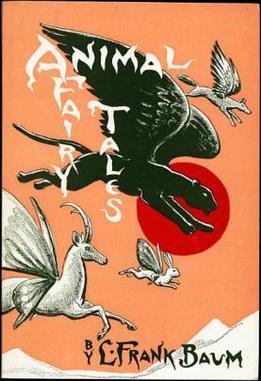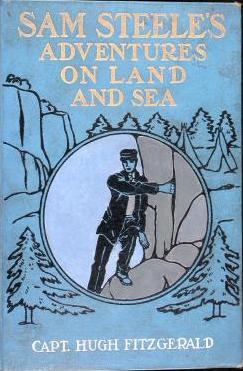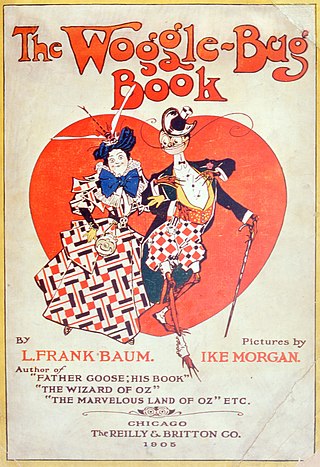
Lyman Frank Baum was an American author best known for his children's fantasy books, particularly The Wonderful Wizard of Oz, part of a series. In addition to the 14 Oz books, Baum penned 41 other novels, 83 short stories, over 200 poems, and at least 42 scripts. He made numerous attempts to bring his works to the stage and screen; the 1939 adaptation of the first Oz book became a landmark of 20th-century cinema.

The Wonderful Wizard of Oz is a 1900 children's novel written by author L. Frank Baum and illustrated by W. W. Denslow. It is the first novel in the Oz series of books. A Kansas farm girl named Dorothy ends up in the magical Land of Oz after she and her pet dog Toto are swept away from their home by a cyclone. Upon her arrival in the magical world of Oz, she learns she cannot return home until she has destroyed the Wicked Witch of the West.

The Wizard of Oz was a 1902 musical extravaganza based on the 1900 novel The Wonderful Wizard of Oz by L. Frank Baum. Although Baum is the credited bookwriter, Glen MacDonough was hired on as jokewriter after Baum had finished the script, and the book was largely ghostwritten by a man named Finnegan. Much of the original music was by Paul Tietjens and has been mostly lost, although it was still well-remembered and in discussion at MGM in 1939 when the classic film version of the story was made. The original show was particularly popular because of its two comedy stars: Fred Stone playing the Scarecrow, and David C. Montgomery as the Tin Woodman.
The International Wizard of Oz Club, Inc., was founded during 1957 by Justin G. Schiller, a then thirteen-year-old boy. The sixteen charter members were garnered from the mailing list found among the papers of the recently deceased Jack Snow, with whom Schiller and the others had discussed the work of L. Frank Baum.

The Magic Cloak of Oz is a 1914 film directed by J. Farrell MacDonald. It was written by L. Frank Baum and produced by Baum and composer Louis F. Gottschalk. The film is an adaptation of Baum's 1905 novel, Queen Zixi of Ix.

The Reilly and Britton Company, known after 1918 as Reilly & Lee, was an American publishing company of the early and middle 20th century, best known for children's and popular culture books from authors like L. Frank Baum and Edgar A. Guest. Founded in 1904 by two former employees of George M. Hill's publishing company, Frank Kennicott Reilly and Charles Sumner Britton. Reilly continued to lead the company until his death in 1932. Britton left the firm around 1916 to start a new company in New York, and for a time the company was guided by William F. Lee, who died in 1924. Following Reilly's death, Francis J. O'Donnell ran the company until it was acquired by the Henry Regnery Company in 1959.

American Fairy Tales is the title of a collection of twelve fantasy stories by L. Frank Baum, published in 1901 by the George M. Hill Company, the firm that issued The Wonderful Wizard of Oz the previous year. The cover, title page, and page borders were designed by Ralph Fletcher Seymour; each story was furnished with two full-page black-and-white illustrations, by either Harry Kennedy, Ike Morgan, or Norman P. Hall.
The Oz Film Manufacturing Company was an independent film studio from 1914 to 1915. It was founded by L. Frank Baum (president), Louis F. Gottschalk, Harry Marston Haldeman (secretary), and Clarence R. Rundel (treasurer) as an offshoot of Haldeman's social group, The Uplifters, that met at the Los Angeles Athletic Club. Its goal was to produce quality family-oriented entertainment in a time when children were primarily seeing violent Westerns. It was a critical but not a commercial success; even under a name change to Dramatic Feature Films, it was quickly forced to fold. The studio made only five features and five short films, of which four features and no shorts survive. Founded in 1914, it was absorbed by Metro Pictures, which evolved into Metro-Goldwyn-Mayer.

The Wonderful Wizard of Oz is a 1900 children's novel written by American author L. Frank Baum. Since its first publication in 1900, it has been adapted many times by L. Frank Baum and others: for film, television, theatre, books, comics, games, and other media.

L. Frank Baum's Juvenile Speaker: Readings and Recitations in Prose and Verse, Humorous and Otherwise is an anthology of literary works by L. Frank Baum, author of the Oz books. The book was first published in 1910, with illustrations by veteran Baum artists John R. Neill and Maginel Wright Enright; a subsequent 1912 edition was retitled Baum's Own Book for Children. The book constitutes a complex element in the Baum bibliography.

Little Wizard Stories of Oz is a set of six short stories written for young children by L. Frank Baum, the creator of the Oz books. The six tales were published in separate small booklets, "Oz books in miniature," in 1913, and then in a collected edition in 1914 with illustrations by John R. Neill. The stories were issued to promote the new Oz novel, The Patchwork Girl of Oz. Each booklet is 29 pages long, and printed in blue ink rather than black.

Animal Fairy Tales is a collection of short stories written by L. Frank Baum, the creator of the Land of Oz series of children's books. The stories first received magazine publication in 1905. For several decades in the twentieth century, the collection was a "lost" book by Baum; it resurfaced when the International Wizard of Oz Club published the stories in one volume in 1969.

Sam Steele's Adventures on Land and Sea is a juvenile adventure novel written by L. Frank Baum, famous as the creator of the Land of Oz. The book was Baum's first effort at writing specifically for an audience of adolescent boys, a market he pursued in the coming years of his career. The novel was first published in 1906, under the pen name "Capt. Hugh Fitzgerald", one of Baum's pseudonyms.

Aunt Jane's Nieces and Uncle John is a young adult novel written by L. Frank Baum, famous as the creator of the Land of Oz. It is the sixth volume in the ten-book series Aunt Jane's Nieces, Baum's greatest commercial success after the Oz books themselves. Like the other books in the series, this sixth volume was issued under the pen name "Edith Van Dyne," one of Baum's multiple pseudonyms.
"The Runaway Shadows, or A Trick of Jack Frost" is a twentieth-century fairy tale, a fantasy short story written by L. Frank Baum, famous as the creator of the Land of Oz. The story is one of a small cluster of Baum narratives that involve his fantasy land the Forest of Burzee and its exotic denizens. Arguably, Burzee constitutes Baum's second most important fantasy realm after Oz itself, being employed in his novels The Life and Adventures of Santa Claus (1902) and Queen Zixi of Ix (1905) and several of his short stories, and is referenced in The Road to Oz (1909).

The Woggle-Bug Book is a 1905 children's book written by L. Frank Baum, creator of the Land of Oz, and illustrated by Ike Morgan. A spinoff from the Oz novels, it has long been one of the rarest items in the Baum bibliography. Baum's text has been controversial for its use of ethnic humor stereotypes.

The Tik-Tok Man of Oz is a musical play with book and lyrics by L. Frank Baum and music by Louis F. Gottschalk that opened at the Majestic Theatre in Los Angeles, California on March 31, 1913. It is loosely inspired by Baum's book Ozma of Oz (1907), incorporates much of the material from Baum's book The Road to Oz (1909), and was the basis for his 1914 novel, Tik-Tok of Oz. It was promoted as "A Companion Play to The Wizard of Oz" and directed by Frank M. Stammers. The play is known from its advertising and published music, but survives only in earlier manuscript.

Nathaniel D. Mann (1866–1915) was an American composer best known for his work with L. Frank Baum. He composed at least two songs with Baum, "Different Ways of Making Love" and "It Happens Ev'ry Day," and another with John Slavin, "She Didn't Really Mind the Thing at All," for The Wizard of Oz stage musical in 1902, and in 1908, composed the first original film score for The Fairylogue and Radio-Plays, one of the earliest feature-length fiction films, which debuted September 24, 1908. With Baum, he also composed the musical The King of Gee-Whiz, which went through various titles such as Montezuma, King Jonah XIII, and The Son of the Sun (1905). This was collaboration with and based on a novel by Emerson Hough, which was never completed and the extant scenario published in 1969.

George M. Hill Company was an American publishing company based in Chicago, Illinois. It was founded in 1893 by George M. Hill, who learned the book-binding trade through an apprenticeship.
The plays of L. Frank Baum are an aspect of Baum's writing career about which very little is known. While most biographies have noted Baum's work as a playwright, these works have been rarely performed beyond his lifetime, and almost none have been published aside from two scenarios and a first act of three unfinished works in The Musical Fantasies of L. Frank Baum, compiled with an introduction by Alla T. Ford. Aside from his youthful success with The Maid of Arran, his blockbuster eight-year run with The Wizard of Oz, his failure with The Woggle-Bug, and The Tik-Tok Man of Oz as source material for his novel, Tik-Tok of Oz, very little is known about his dramatic output, and mostly from the publications of Michael Patrick Hearn, Susan Ferrara, and Katharine M. Rogers. Hearn identifies 41 different titles in the bibliography of the 2000 edition of The Annotated Wizard of Oz, plus one play without a title, although some of these titles clearly refer to drafts of the same play, such as the early titles of The Tik-Tok Man of Oz.















